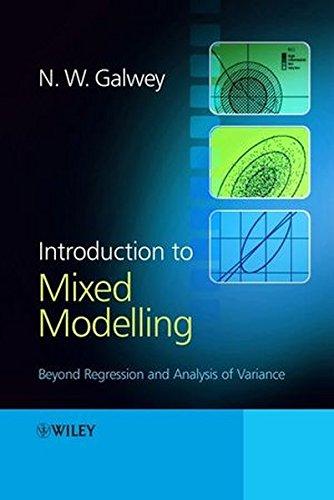Two inbred cultivars of wheat were hybridised, and seed of 48 F2-derived F3 families (i.e., families in
Question:
Two inbred cultivars of wheat were hybridised, and seed of 48 F2-derived F3 families (i.e., families in the third progeny generation, each derived by inbreeding from a single plant in the second progeny generation) was obtained. The seed was sown in field plots in competition with ryegrass, in two replications in a randomised block design, with ‘family’ as the treatment factor. The mean grain yield per plant was determined in each plot. The results obtained are presented in Table 3.14. (Data reproduced by kind permission of S. Mokhtari.) In the analysis of these data, ‘family’ will be regarded as a random-effect term.
(a) Justify this decision.
(b) Analyse these data by analysis of variance and by mixed modelling. Determine whether the variation among families is significant according to the F test.
(c) Obtain estimates of the variance components for the following model terms: (i) Residual (ii) family (iii) block.
(d) Compare the estimate of the variance component for the term ‘family’ with its standard error. Does their relative magnitude suggest that this term might reasonably be dropped from the model?
(e) Test the significance of the term ‘family’ by comparing the deviances obtained with and without the inclusion of this term in the model.
(f) Obtain diagnostic plots of the residuals from your analysis. (g) Compare the results of the significance tests conducted in Parts
(b) and
(e) with each other, and with the informal evaluation conducted in Part (d). Consider how fully the assumptions of each test are likely to be met. Considered together, do these tests indicate that the term ‘family’ should be retained in the model? (h) Estimate the heritability of yield in this population of families. (Note that the estimate obtained using the methods described in this chapter is slightly biased downwards, as some of the residual variance is due to genetic differences among plants of the same family.) (i) Estimate the genetic advance that is expected if the highest-yielding 10 % of the families are selected for further evaluation. Find the expected mean yield of the selected families, and compare it with the observed mean yield of the same families. Account for the difference between these values. Exercises 121 Table 3.14 Yield per plant (g) of F3 families of wheat grown in competition with ryegrass in a randomised block design. A B C 1 block family yield 2 1 11 3.883 3 1 9 3.717 4 1 7 3.850 5 1 41 1.817 6 1 2 7.483 7 1 25 3.483 8 1 10 2.500 9 1 38 3.683 10 1 32 1.167 11 1 42 12 1 23 0.717 13 1 8 2.883 14 1 17 5.883 15 1 43 2.900 16 1 5 2.650 17 1 16 2.517 18 1 21 1.933 19 1 18 2.417 20 1 15 3.683 21 1 44 0.940 22 1 36 4.617 23 1 20 2.817 24 1 1 4.260 25 1 22 2.667 26 1 40 6.917 27 1 35 7.883 28 1 6 3.050 29 1 14 2.533 30 1 29 5.400 31 1 45 3.150 32 1 3 2.150 33 1 28 1.367 34 1 19 0.733 35 1 26 1.700 (Continued overleaf ) 122 Estimation of the variances of random-effect terms Table 3.14 (continued) A B C 36 1 30 1.800 37 1 46 1.720 38 1 12 4.083 39 1 27 3.667 40 1 31 4.317 41 1 39 4.033 42 1 47 1.950 43 1 4 5.000 44 1 24 2.600 45 1 34 4.250 46 1 13 4.300 47 1 33 4.250 48 1 37 3.783 49 1 48 2.617 50 2 9 8.550 51 2 11 9.633 52 2 5 5.733 53 2 25 8.117 54 2 39 4.633 55 2 21 1.450 56 2 41 3.240 57 2 42 58 2 14 2.850 59 2 37 3.850 60 2 19 5.020 61 2 36 8.740 62 2 43 1.300 63 2 16 4.600 64 2 29 9.100 65 2 6 4.600 66 2 8 4.900 67 2 44 4.400 68 2 1 4.900 69 2 35 4.283 70 2 3 5.233 71 2 13 3.717 72 2 26 4.717 Exercises 123 Table 3.14 (continued) A B C 73 2 28 2.817 74 2 12 7.467 75 2 33 4.567 76 2 45 5.480 77 2 34 7.933 78 2 18 4.833 79 2 7 4.933 80 2 2 5.300 81 2 31 7.500 82 2 40 3.083 83 2 46 2.900 84 2 10 4.917 85 2 32 4.400 86 2 17 6.533 87 2 23 5.783 88 2 27 4.767 89 2 38 4.867 90 2 30 3.983 91 2 22 4.017 92 2 47 1.775 93 2 48 1.540 94 2 20 95 2 24 8.033 96 2 4 4.020 97 2 15 3.183 (j) When these estimates of genetic advance and expected mean yield are obtained, what assumptions are being made about the future environment in which the families are evaluated? These data have also been analysed and interpreted by Mokhtari et al. (2002).
Step by Step Answer:





